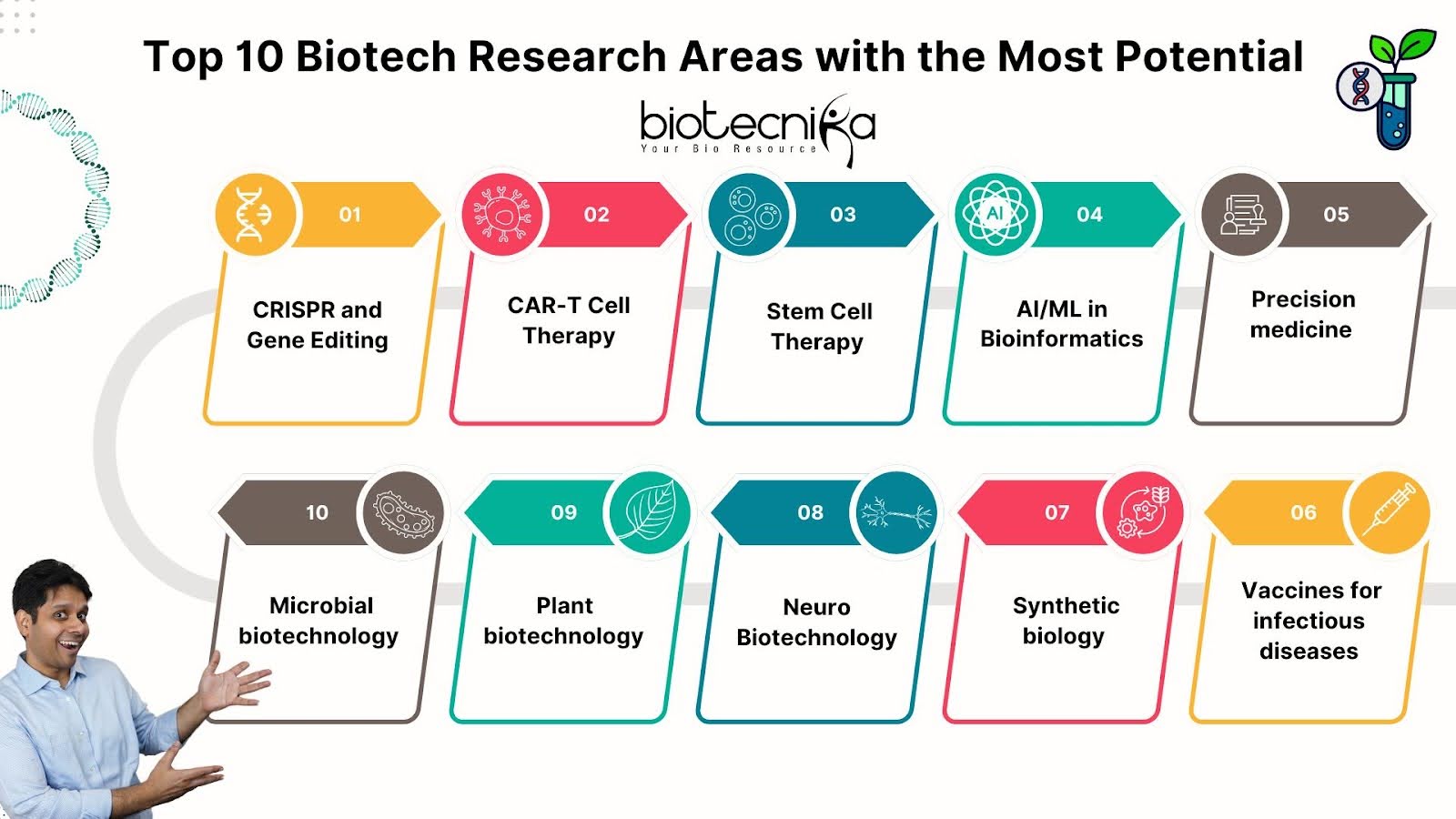Top 10 Biotech Research Areas With the Maximum Growth Potential!
“In the world of biotechnology, imagination is the only limit to what we can achieve.”
As the years rolled on, the one field that saw massive and constant growth was biotechnology.
With the emergence of new diseases, innovation to combat these diseases has also happened.
New technologies have been explored in the biotech and healthcare sector, from marvels of gene editing to the promise of personalized medicine to secrets of microbiome research,the field is transforming every day, and with that our way of approaching the most concerning matters of the world has also changed.
Unimaginable things have been achieved by harnessing the power of science.
So what’s next? What path-breaking research is going to revolutionize the biotech scene? Curious about it?
Dive into the top 10 biotech research areas that have the most potential. Come, let’s have a look at them.
CRISPR – From Curing Diseases to Superhumans
CRISPR (Clustered regularly Interspaced short Palindromic repeats) is a breakthrough in gene editing. It provides an accurate, efficient, and cost-effective method to alter DNA. Researchers can employ the CRISPR-Cas9 system to target particular genes for deletion, addition, or alteration, which can have massive implications for medicine, agriculture, and environmental conservation. CRISPR can be used to treat several genetic disorders like cystic fibrosis and muscular dystrophy. On the other hand CRISPR can also be used for agricultural purposes, gene-edited crops can be designed so that these crops become more resistant to pests, drought and diseases.
Currently, CRISPR research is moving in a direction wherein it’s more than just a basic gene editing tool. Advancements in CRISPR research are exploring areas like therapeutic applications for complex genetic diseases and developing systems for more precise and safe genome Editing. The only thing stopping its advanced at a larger scale is ethical concerns that should be addressed.
You Won’t Believe What CAR-T Cell Therapy Can Do!
Immunotherapy has been identified as a breakthrough for a cancer treatment, leveraging the strength of the immune system to combat the disease. There are various types of immunotherapies, CAR-T Cell therapy is one of the most promising treatments amongst them. CAR-T Cell therapy has developed significant excitement, for its ability to cure certain blood cancers like leukemia and lymphoma. This opens a new line of treatment for patients, who do not respond to the conventional ways of treatment.
Researchers aim to expand the applications of CAR-T Cell for treating solid tumors, as they are more challenging to treat. On the contrary, CAR-T Cell therapy is quite expensive, and has side effects like severe immune reactions. Further Research & advancement in this field will help us work on minimizing these side effects and make CAR-T therapy more broadly applicable and affordable.
Cure the incurable with Stem Cell Therapy!
As the name suggests, stem cell therapy aims to repair to replace damaged organs or tissues with the application of stem cells. Stem cell therapy particularly, is a very promising method to treat a wide range of health conditions, from heart diseases to spinal cord injuries. What makes stem cells so special is their ability to divide into different types of cells, which makes them eligible for treating or repairing damaged tissues or organs. Scientists are also exploring, to apply stem cell therapy to treat neurodegenerative diseases. Stem cell therapy has great potential to revolutionize treatment of a vast number of diseases, but nevertheless, so challenges remain, such as ethical concerns regarding the use of embryonic stem cells and difficulty in controlling the growth of stem cells.
Coming to iPSCs – Recent advancements in induced pluripotent stem cells (iPSCs) are helping researchers increase the versatility of stem cell therapy, allowing them to reprogram adult cells back to an embryonic-like state. This breakthrough enables the generation of patient-specific cells.
iPSCs are now being explored for their ability in various aspects, mentioned below:
- To model diseases in the laboratory
- Test drug responses
- And even regenerate damaged tissues in conditions such as diabetes and Parkinson’s disease, offering a promising frontier for personalized medicine.

AI Ml is the future of Biotech!
Years of research on genomics, proteomics and other omics fields has generated a humongous amount of data that can’t be analyzed by the traditional analytical method, but with the help of AI and Machine learning tools complex data can be analyzed very easily and also makes understanding such data. AI-driven algorithms can be used to predict disease outcomes and discovery of new and advanced drugs. Massive growth is expected in this sector, as the computational models become more developed and sophisticated, which accelerates the advancements in the field of drug discovery and precision medicine.
Further, it will be interesting to see the amalgamation of AI & robotics to automate laboratory processes, increasing both the speed and reproducibility of scientific experiments.
Forget One-Size-Fits-All – Precision Medicine is here!
Precision medicine which has the ability to transform healthcare facilities. Precision medicine allows treatments to be tailored as per the requirements and genetic makeup of the patients. Pharmacogenomics is a part of the field, which deals with the study of how genes play a role in how a person’s body reacts to drugs, which ensures maximum efficiency and least side effects.
In today’s time, integration of genetic information with clinical data has become very common, and research is mainly focused on increasing the efficacy of diagnostic tools that guide the precision treatment process. Precision treatment is specifically relevant in oncology, where the treatment is customized as per tumor genetics.
The Secret Weapon Against Infectious Diseases – Vaccine Development
With the emergence of COVID-19 pandemic, urgent need for vaccines also emerged to save lives, which also stressed upon the importance of vaccines for infectious diseases. Biotechnology has played a pivotal role in development of next generation vaccines using protein subunits, mRNAs and viral vectors.These vaccines are not only being used to fight against COVID-19, but also used for prevention against fatal diseases like HIV, influenza and malaria.
With vaccines that fight particular strains of viruses, scientists are also focused on developing vaccines that can quickly adapt to new viral strains or prevent infection against multiple pathogens. In addition to this, novel delivery systems like nasal sprays or microneedles are also gaining popularity for their efficacy to enhance the global immunization trends.

Can We Engineer Life?
Synthetic biology is a field that harnesses the power of biology, engineering, and computer science to design and create new biological systems or re-engineer old ones. Synthetic biology aims to program living organisms with personalized genetic networks, which enables the construction of novel biological functions that are not found naturally. The potential of this technology is huge, ranging from healthcare and agriculture to industry. To cite an example, synthetic organisms can be used to produce biofuels, pharmaceuticals, or biodegradable materials, which proposes a sustainable option when compared to fossil fuel-based products. The ability of synthetic organisms to program themselves opens a path for unbelievable innovations that make synthetic biology an area of great interest for researchers.
Recent breakthroughs in synthetic biology that are noteworthy:
- Creation of Synthetic Genomes
- Gene Drives: Engineering gene drives using CRISPR to control disease-spreading insect populations, like mosquitoes carrying malaria.
- Development of Living Materials / Self Repairing Materials
- Biosynthesis of Pharmaceuticals
- Artificial Photosynthesis: A synthetic system has been developed that mimics the photosynthesis process, converting CO2 into organic compounds
Hacking the Human Brain via Neuro-biotechnology
Neuro-biotechnology is a field that aims to understand and manipulate the nervous system for the treatment of neurological diseases and enhance the function of the brain. Neurological disorders such as Alzheimer’s, Parkinson’s and depression have become matters of global concern, hence researchers’ interest in these fields has also increased. Scientists are using advanced technologies such as optogenetics, neuroprosthetics and brain- computer interfaces to repair damaged neural networks, improve brain function or even attempt to merge biological intelligence with digital intelligence.This kind of technology not only promises to treat the diseases but also enhance human cognition.
Recent advances in neurotechnology – highlighting the remarkable work of Elon Musk’s Neuralink in this field.
- Development of ultra-high bandwidth brain-machine interfaces for direct brain-to-device communication.
- Implementation of fully implantable, wireless devices to enhance user mobility and comfort.
- Real-Time Brain Activity Monitoring & Simulations
- Initiating Human clinical trials to explore treatments for neurological conditions like paralysis and Alzheimer’s.
The Hidden Power of Agricultural Biotechnology
The role of biotechnology in food production and security is essential as it helps in developing crops that are resistant to pests, diseases, and extreme climatic conditions. Gene-edited crops, drought-resistant plants, and biofortified foods are innovations that help address the global concern of feeding the rapidly growing population. With growth in the biotech field and gene editing technologies like CRISPR, the development of nutritionally improved and environmentally more tolerant crops is more achievable than ever.
Microbial Magic: How Tiny Organisms Can Revolutionize Science!
Microbial biotechnology uses microorganisms, such as fungi, bacteria, and yeast, to perform important industrial processes in different industries like medicine, agriculture, and environmental science. By harnessing the power of genetically modified microbes, scientists optimize their ability to clean up environmental pollutants through bioremediation, produce biofuels and create environmentally sustainable bio-based chemicals. Microbial biotechnology has also made its place in the healthcare industry as well, microbes are being engineered to produce life-saving drugs including insulin, antibiotics and vaccines. The impact of microbial biotechnology is enormous, as it offers sustainable solutions to global concerns like energy management, food security, and waste management.
With the above points discussed, we can understand that biotechnology has broken all myths regarding its potential to transform research and has taken its place in all industries, such as healthcare and agriculture. These fields continue to evolve and innovate to come up with more sustainable solutions. Researchers, students, and professionals working in biotechnology should look out for opportunities in these cutting-edge areas.
Keywords: Top 10 Biotech Research Areas






































